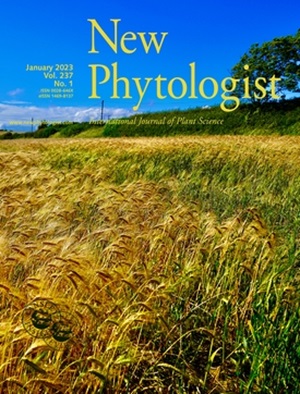自然生态系统中植物真菌病菌病菌同域寄主特化谱系的进化
IF 8.3
1区 生物学
Q1 PLANT SCIENCES
引用次数: 0
摘要
引言传染性真菌疾病的出现和严重程度不断增加,威胁着粮食安全和自然生态系统(Fisher 等人,2012 年;Stukenbrock & Gurr,2023 年)。对野生植物寄主中真菌病原体的持续监测、疾病传播预测建模和深入了解在很大程度上被忽视了。这对于剖析真菌病原体对气候变化的影响以及独立于农业环境的影响至关重要(Fisher 等人,2012 年)。目前有证据表明,作物野生近缘种(CWRs)可作为驯化植物病原体的贮藏库(Monteil 等人,2013 年,2016 年),但有关野生病原体种群过程和动态的研究仍然很少(Rouxel 等人,2013 年;Penczykowski 等人,2015 年;Eck 等人,2022 年;Treindl 等人,2023 年)。CWRs 具有更高水平的遗传多样性,并在自然生态系统中与植物病原体共同进化。此外,作物植物的多样性和驯化中心蕴藏着丰富的物种(Harlan,1971 年),可作为植物病原体的宿主(Vavilov,1992 年)。尽管如此,自然生态系统的经济价值却被低估,这限制了研究资金的投入(Fisher 等人,2012 年)。此外,在偏远地区或复杂的地缘政治背景下获取野生物种又增加了一层困难,这就造成了对高收入地区的地理偏向,从而牺牲了对剩余生物多样性的探索(Marks 等人,2023 年)。克服这一问题的方法之一是通过与全球代表性较低地区的科学界合作,优先考虑被忽视的领域(Marks 等人,2023 年),并促进对自然生态系统中的非模式物种和动态的研究。正如 Crous & Groenewald(2005 年)所提出并在多项研究(Steenkamp 等人,2002 年;Choi 等人,2011 年;Rouxel 等人,2013 年;Faticov 等人,2022 年)中例证的那样,植物病原体系统发育经常代表多个密切相关的姊妹种或隐蔽种。在这方面,Zymoseptoria 属由 8 个子囊菌种组成,其中只有两个,即 Zymoseptoria tritici 和 Zymoseptoria passerinii (Sacc.) Quaedvlieg & Crous,被报道感染驯化宿主(Quaedvlieg 等人,2011 年;Stukenbrock 等人,2012 年 b)。在农业背景下,对小麦真菌病原体 Z. tritici 的起源、种群遗传学和植物病原体动力学进行了广泛研究(Linde 等人,2002 年;Stukenbrock 等人,2011 年;McDonald 等人,2022 年;Orellana-Torrejon 等人,2022 年;Feurtey 等人,2023 年)。Zymseptoria tritici 和 Z. passerinii 的地理范围相互重叠,并在其原产地中心发生了共生多样化(Rojas-Barrera 等人,2023 年)。然而,我们对它们的种群遗传学以及多个同域宿主对自然生态系统中病原体流行的影响的了解仍然有限(Stukenbrock 等人,2011 年,2012a)。对 Z. tritici 的种群遗传学研究表明,Zymoseptoria 属的多样性中心位于中东地区(Banke et al、2004),毗邻被公认为作物驯化中心的新月沃地(Harlan,1971),那里有大量的 CWRs 自然分布(Harlan & Zohary, 1966)。在 20 世纪 90 年代末到 21 世纪初,半生真菌 Z. passerinii 在美国上中西部和加拿大邻近省份的最后一次大爆发中变得非常重要(Toubia-Rahme & Steffenson, 2004)。在此期间,对 2003 年和 2004 年在北达科他州和明尼苏达州西部采集的 309 株分离株进行了广泛研究,结果显示 Passerinii 的遗传多样性很高,种群结构较浅(Lee & Neate, 2007b),两种交配类型的频率均衡(Lee & Neate, 2007a),表明其为有性生殖。然而,这种病原体的远缘阶段只在实验条件下报道过,在野外还没有描述过(Ware 等人,2006 年)。有趣的是,尽管 SSLB 在本世纪初很重要,但据我们所知,目前还没有关于 SSLB 在北美或其他地区(包括中东)爆发的报道。病害三角区指出,在决定病害流行的严重程度方面,有利的气候变量与植物特征同样重要(Stevens,1960 年)。因此,SSLB 的零星发生归因于孢子萌发需要 48 小时的持续湿度(Green & Dickson, 1957)和较长的潜伏期(16-19 d)(Koble 等人,1959;Cunfer, 2000),这表明它对天气条件有很强的依赖性。本文章由计算机程序翻译,如有差异,请以英文原文为准。

Evolution of sympatric host-specialized lineages of the fungal plant pathogen Zymoseptoria passerinii in natural ecosystems
求助全文
通过发布文献求助,成功后即可免费获取论文全文。
去求助
来源期刊

New Phytologist
生物-植物科学
自引率
5.30%
发文量
728
期刊介绍:
New Phytologist is an international electronic journal published 24 times a year. It is owned by the New Phytologist Foundation, a non-profit-making charitable organization dedicated to promoting plant science. The journal publishes excellent, novel, rigorous, and timely research and scholarship in plant science and its applications. The articles cover topics in five sections: Physiology & Development, Environment, Interaction, Evolution, and Transformative Plant Biotechnology. These sections encompass intracellular processes, global environmental change, and encourage cross-disciplinary approaches. The journal recognizes the use of techniques from molecular and cell biology, functional genomics, modeling, and system-based approaches in plant science. Abstracting and Indexing Information for New Phytologist includes Academic Search, AgBiotech News & Information, Agroforestry Abstracts, Biochemistry & Biophysics Citation Index, Botanical Pesticides, CAB Abstracts®, Environment Index, Global Health, and Plant Breeding Abstracts, and others.
 求助内容:
求助内容: 应助结果提醒方式:
应助结果提醒方式:


